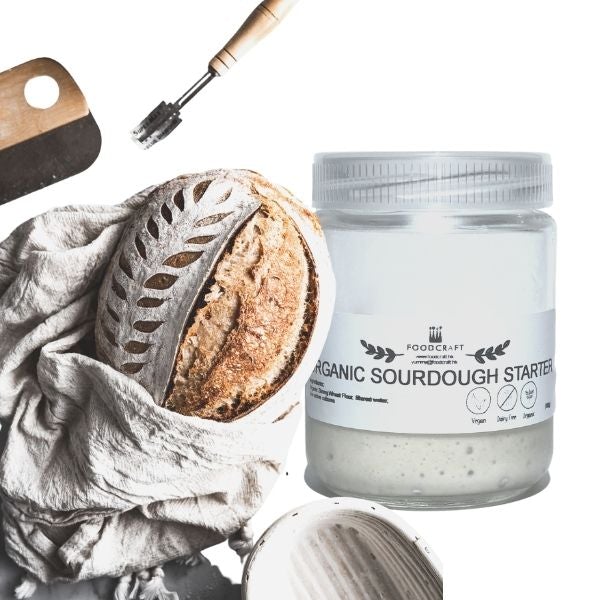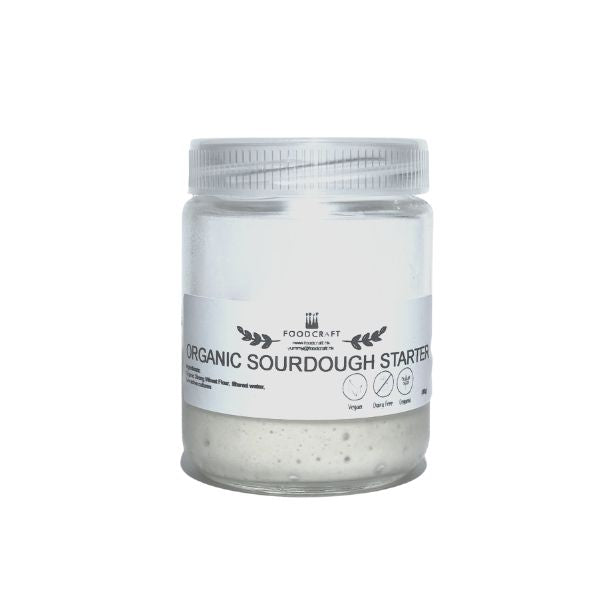
Sourdough Starter - All the Basics You Need to Know
Your 101 guide to feeding and maintaining your Sourdough Starter
Ever since the pandemic, our 'Sourdough Baking Series' has been topping the chart for the most-participated and the hype has not ceased a bit.
I think the logic is behind it. When given the time and space to spare, a habit is essentially born. When it comes to the satisfaction of baking your own bread...you feel yourself elevated from the process and result. In other words, a fresh-out-of-the-oven sense of achievement.
Over the years, FoodCraft Customer Service and myself receive numerous questions on how to maintain the Sourdough Starter so it makes sense that I am led to demystifying the rocket science of baking a Sourdough loaf and reveal the secrets - not really! What the objective here really is, is the explication of the million-dollar question: "How do you keep the Sourdough Starter' alive?".
All will be answered for the love of Sourdough loaves.
So what is 'Sourdough'?
Sourdough is active and living yeast with popping bubbles and its growing mass you can observe... any of this sounds like we have got our science journals pulled out? If you have already been fostering your own Sourdough at home or you recently adopted one from our Sourdough Starter Kit, you might understand to what extent it is.... 'alive'.
Now, as a caretaker for a Sourdough Starter that is coming to 16 years of age (yes, FoodCraft's Sourdough Starter has been following me everywhere long before the company signed up for service!), I want to share my tips for 'mothering' a Sourdough Starter. Once you become a Sourdough-baker in your own pantry, you become a Mom or a Dad of your little baby, the Sourdough Starter. Thus, the parenting from this blog.
Sourdough baking starts with taking care of the Sourdough Starter.
And 'Sourdough Starter', give us your best guess!

The Sourdough Starter is a wet, sticky dough of fermenting flour and water mixed together. How does it develop into a bread in the process?
"Wild yeast", the natural yeast bacteria in the air, they help convert the grains' natural sugar content and the starch in the flour into carbon dioxide - creating beautiful air pockets that will allow the dough to rise! Additionally, they also help convert the gluten in the dense dough - the protein in wheat - into lactic acid, giving the Sourdough a unique and rich flavour.
This wild yeast takes its time to go through the gluten (wheat protein). When bread is made with fast-rising yeast, the bacteria is not given time for any pre-digestion. Another reason to why customers reflect to us on feeling bloated after consuming the bakery items by other bakeries.
*NOTE: Sourdough breads are not gluten-free! But you can make it.
In our baking classes, I find people usually struggle maintaining a well and happy Sourdough Starter.
This is likely due to the lack of attention during the fermentation process.
Sourdough Starter lives a cycle, just like us!
Your Starter will repeatedly go through the stages of rising, peaking and sinking after each feed. The length of time is greatly affected by the environment's temperature and humidity so it is not easily determined how much time will this process take up in your kitchen. Check out the photos of the gradual stages that a fed and fermenting Sourdough Starter will go through. It is very important for you to understand the purpose of each stage.
When you have just fed the Sourdough Starter, the Starter will look flat and dense. I like to call this a 'Young Starter'.
Stage 1. When you receive our Sourdough Starter, it will be looking like this👇🏻👇🏻👇🏻

Stage 2. Rising Stage 👇🏻👇🏻👇🏻

Stage 3. Peaking Stage 👇🏻👇🏻👇🏻

At which stage should I use the Sourdough Stater for baking?
Without wonder, of course we bake with the Sourdough Starter at its "peaking stage".
When the Starter reaches is 'peaking', it will expand to twice or more of its original size. This means the Starter has reached a fully fermented status!
It is not ideal to use a rising “young” Sourdough Starter for baking because the fermentation has yet to be mature has not been completed. Nor should you use a Sourdough Starter that has gone through the complete cycle and has deflated and gone 'hungry'.
When should I feed my Sourdough Starter?
The peak period will last for several hours only and the Starter will have a slightly sour and vinaigrette taste. Don't panic, this piercing yeast smell is completely normal and you can use it with confidence.
Still remember in Economy, what happens after an exponential growth? Guessed it right, here comes the 'sinking stage'.
When it starts to sink, your Starter will have a very sour or even a weak alcoholic smell (ethanol-like), that tells you it is time to feed the Starter again!
How long does it take from feeding the Sourdough Starter to peaking?
The pace of your Sourdough Starter's fermentation is affected by the following factors:
• Temperature: higher temperature = faster fermentation, low temperature = slower fermentation
• Humidity: high humidity = faster fermentation, low humidity - slower fermentation
• Remaining amount: more starter = faster fermentation, less starter = slower fermentation
• Flour type: Not all flours ferment at the same rate. Our Sprouted Spelt Flour is easier to ferment than high-gluten flour. You can test this with the flours you have on hand to observe the difference.
How to feed your Sourdough Starter?
The only way to feed a Sourdough Starter is to give it flour and water, a way more inexpensive way of raising a child!
I typically feed it 1:1 ratio of flour and water by the weight. Simply mix the remaining Sourdough Starter in your jar with 30 grams of flour and 30 grams of filtered water. The flour can be your favorite flour mix or an ordinary high-gluten flour.
Once the flour and water are fed to the Starter and it starts bubbling up, the fermentation process will begin. You should see the Starter more and more bubbles surfacing and expanding.
If your jars starts to overflow with the Starter, its time to 'discard' - heard of this but not sure what it is?
Discarding the Sourdough Starter is a thing you do to make space in your Sourdough Starter jar so that you can feed it fresh flour and water again. People typically throw away half of the overflowing portion of what was once your baby Sourdough Starter in jar.
Feel attached to the discard?
Don't! You can use it in your "discard" baking. Just Google 'Sourdough discard recipe' and you'll find a list of things you can do with your discard! It seems most people like to use the Sourdough discard for pancakes, waffles or muffins.
How to preserve your Sourdough Starter?
You can put your Starter in the refrigerator for up to 7 days without feeding. When preparing to bake, please feed the Starter with the above instructions on feeding (at room temperature) before starting to bake. Please remember that you need to keep feeding your *Sourdough Starter even you are not baking. The feeding is a MUST, for preserving the yeast in the Sourdough Starter.
If you will not be baking for more than a week, you can store away your Starter in the freezer for up to 1 year. When ready to bake again, put the Starter at room temperature to thaw and proceed to feeding by the normal procedure. It may be necessary to repeat feeding 2-3 times until the Starter is fully activated.
Hope these steps can help you bake a satisfying Sourdough Bread! Check out FoodCraft Bakery's bake-to-order collection: Pre-order your Sourdough Bread(s)
Don't fret, we will have instructions included in our Sourdough Starter Kit too! And if you really need backup, join us in our Sourdough Baking Class Level 1 or Level 0, I will guide you myself and in-person!
By the way, we have 2 different types of Sourdough Starters.
One is the 'Organic Sourdough Starter (contains gluten)' made with bread flour that contains wheat. The other is the 'Gluten-free Sourdough Starter'.
For any questions you may have, please contact us, we are happy to cover them!

Leave a comment